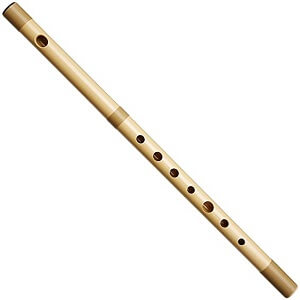Shinobue
 The shinobue is one of the Japanese woodwind instruments. The shinobue is a transverse flute with a simple structure, and it is made from shinodake (small bamboo); Simon bamboo (Pleioblastus simonii), whose inner side is coated either in lacquer or synthetic resin, having two openings for Utaguchi (the mouthpiece of the shakuhachi) and tone holes. In traditional performing arts, the shinobue is often called the 'fue' or 'takebue' for short. It is categorized as a reed instrument such as the shakuhachi (Japanese end-blown flute) or the flute.
The shinobue is one of the Japanese woodwind instruments. The shinobue is a transverse flute with a simple structure, and it is made from shinodake (small bamboo); Simon bamboo (Pleioblastus simonii), whose inner side is coated either in lacquer or synthetic resin, having two openings for Utaguchi (the mouthpiece of the shakuhachi) and tone holes. In traditional performing arts, the shinobue is often called the 'fue' or 'takebue' for short. It is categorized as a reed instrument such as the shakuhachi (Japanese end-blown flute) or the flute.
The shinobue has a simple form which resembles a piece of bamboo and do not usually have any decoration aside from being wrapped in to (Japanese wisteria) and coated in lacquer to prevent bamboo from cracking. This is probably the major reason why the shinobue was favored among the common people. The ryuteki flute and nohkan flute, which were used by the upper classes such as court nobles and samurai, differ greatly from the shinobue in that they are adorned with decoration requiring time and care such as wrapping and paintings.
The shinobue is not thought to have been created in Japan but is rather thought to have developed from the ryuteki flute imported from China as a yokobue (transverse flute) for gagaku (ancient Japanese court dance and music) and simplified as it spread throughout the common people. Further back in history, it is said that transverse flutes around the world originated in the ancient India.